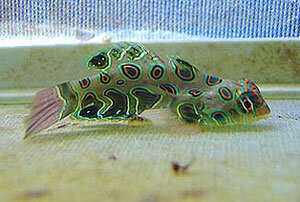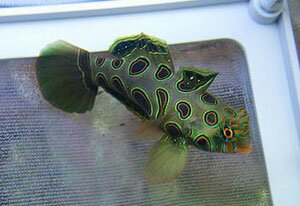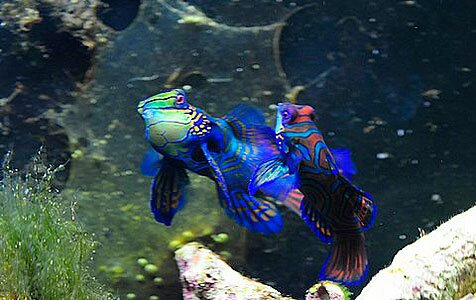|
Synchiropus picturatus - Green Mandarinfish
Keeping Green Mandarinfish in the Home Aquarium  Green mandarinfish (Synchiropus splendidus) are very popular marine aquarium fish—they also can be a difficult fish to keep, given their very specific husbandry needs. Green mandarins can, in fact, be so difficult to keep that Bob Fenner, author of The Conscientious Marine Aquarist, writes that they “have one of the most dismal survival records of captive marines.” While this is no doubt the conventional wisdom—and it is grounded in tried and true experience—there are some intrepid aquarists who are challenging the status quo and who actually believe that much of the conventional wisdom regarding mandarinfish is but a myth given the latest husbandry methods. Regardless of whether you approach keeping a green mandarinfish with traditional husbandry or from the perspective of the new mandarinfish school (which will be discussed in this article), rest assured that almost any dedicated aquarist can have success with these dazzlingly beautiful marine fishes. Green mandarinfish (Synchiropus splendidus) are very popular marine aquarium fish—they also can be a difficult fish to keep, given their very specific husbandry needs. Green mandarins can, in fact, be so difficult to keep that Bob Fenner, author of The Conscientious Marine Aquarist, writes that they “have one of the most dismal survival records of captive marines.” While this is no doubt the conventional wisdom—and it is grounded in tried and true experience—there are some intrepid aquarists who are challenging the status quo and who actually believe that much of the conventional wisdom regarding mandarinfish is but a myth given the latest husbandry methods. Regardless of whether you approach keeping a green mandarinfish with traditional husbandry or from the perspective of the new mandarinfish school (which will be discussed in this article), rest assured that almost any dedicated aquarist can have success with these dazzlingly beautiful marine fishes.
Family Background
Frequently sold as dragonets in the hobby, the mandarinfishes are properly Callionymids (Family Callionymidae), although they are sometimes sold as gobies or even blennies (e.g., scooter blennies, Synchiropus ocellatus). Of the more than 15 genera, only a couple genera are seen with any degree of frequency in the hobby. Within the most popular genus, Synchiropus, several species are commonly seen in the hobby including Synchiropus stellatus, S. ocellatus, S. picturatus. and, the subject of this article, S. splendidus.
The Green Mandarinfish
Synchiropus Synchiropus, commonly known as the green mandarinfish, the striped mandarinfish, the picturesque mandarinfish, or the psychedelic mandarinfish is one of the most commonly seen mandarinfishes in the hobby. This fish is unmistakable given its stunning color and markings.
 
Above: Emaciated Spotted Mandarinfish (left) and Healthy Mandarinfish (right) by Matt Wittenrich
Unfortunately, many beginning aquarists purchase this fish without realizing how to appropriately care for it. To compound matters, it is not at all unusual to see only emaciated mandarinfishes (above left) offered for sale at the local fish store. As such, selection becomes essential when choosing a mandarinfish. If you purchase from an online retailer like Blue Zoo Aquatics, you should expect a healthy-looking (read alert and not emaciated, above right) specimen to be selected for you. If you purchase from a local fish store, choose only individuals that are active and aware of their surroundings. Always ask to see them eat before purchasing.
Husbandry – Conventional Wisdom
Conventional wisdom suggests the aquarist should not even consider keeping a green mandarinfish in a home aquarium that is less than 75 gallons and less than six to nine months old (even better to wait a year). The ideal mandarinfish aquarium has plenty of live rock and an attendant population of small invertebrate life upon which the green mandarin can feed. If you intend to keep other species that compete for the same food source, the aquarium must be even larger, although a connected refugium can go a long way toward providing a stable live food source. This approach to keeping mandarinfishes is rooted in the idea that it is difficult to wean these fishes onto a captive diet and then keep up with their near constant foraging behavior.
Husbandry – The New School
Remember, the previous paragraph opened with “conventional wisdom suggests”? Now meet Matt Wittenrich. Wittenrich, a doctorate candidate at Florida Institute of Technology and author of The Complete Illustrated Breeder's Guide to Marine Aquarium Fishes, is not a conventional guy, and, perhaps not surprisingly, his “mandarins-are-no-longer-a-for-experts-only-fish” philosophy is rather unconventional. For example, Wittenrich refers to the necessity of providing a spacious, mature, live rock-filled aquarium as little more than “a myth.” So what is this new school all about?
Wittenrich emphasizes two critical steps to success with any mandarinfish. First, the aquarist must start with a healthy individual, and second, the aquarist must wean that individual onto a captive diet consisting of frozen fare. “The challenge of acquiring healthy stock is the major hurdle,” Wittenrich admits, “but this really determines if a specimen is to survive in captivity.”Assuming a healthy specimen is obtained, part two—weaning the fish onto a captive, frozen food diet—is really not that difficult.
Weaning Your New Green Mandarinfish
“Spotted mandarins (S. picturatus) are usually ready feeders and require little weaning to get their attention with frozen mysid shrimp,” he says. “Often, spotteds will pick frozen fare from the water column like a butterfly.” Green mandarinfish are somewhat more difficult to wean and require more patience on the part of the aquarist, but they are, in Wittenrich’s experience, well within the reach of the dedicated aquarist.
“The best method I have seen to wean green mandarins was put forth by Matt Pedersen,” Wittenrich says. “He puts newly acquired specimens in a breeder box, feeds them enriched live brine and slowly starts introducing frozen brine and mysids to the regime. Once the mandarins begin accepting the frozen fare, the live stuff is slowly removed from the diet.” Wittenrich feeds Piscince Energetics mysids exclusively to his mandarins. “They love it,” he says, “usually with little weaning.”
Quarantining Your New Green Mandarinfish
Rather than placing your new green mandarinfish into a massive reef tank full of live rock and lots of hiding places, Wittenrich suggests you initially isolate your new green mandarin in a relatively small and open tank to facilitate feeding and observation. “Offer high quality mysids (e.g., Piscince Energetics) and keep a low current running across the gravel to keep the frozen fare slowly rolling about the substrate to give the illusion of live prey.” This quarantine period, which is usually skipped with mandarinfish by many traditional aquarists in favor of getting the animal into the display tank where the live food is, is added insurance against external parasites, but more on this in a bit.
Compatability
Most callionymids are peaceful fishes, and the green mandarin is no exception. As a result, green mandarinfish must be kept with peaceful tankmates who will not out-compete them for food or harass (or even prey on) them. Some invertebrates (e.g., large anemones) can be a problem as well, as they may kill a green mandarinfish. With the proper tankmates, the green mandarinfish is an excellent reef tank specimen. It is best to keep the green mandarinfish either one to a tank, in a confirmed pair or in a group that includes only one male.
Infestation, Disease and Treatment
Once a green mandarinfish is feeding, it should prove to be a hardy aquarium specimen. These fishes, owing to their excessive slime coat, are not overly susceptible to infestation by external parasites. For this reason, it has often been recommended to forego a full quarantine in favor of getting the fish into the mature display tank where all the good live food is. With Wittenrich’s approach, however, a standard quarantine in a relatively bare quarantine tank (with gravel) is appropriate, as it gives the aquarist a chance to observe that the fish is eating a captive diet and to insure that it is not carrying any parasites. In the event that a mandarinfish is determined to be infested with an external parasite (e.g., crypto), it is best to rely on alternative treatment methods (e.g., hyposalinity) rather than the standard copper, as most Callionymids do not tolerate copper well.
Closing Thoughts

Above: Courtship ritual with a new pair, smaller female at right by Matt Wittenrich
Whether you take the traditional approach of a large, mature, live rock-filled aquarium or the new school approach of weaning your green mandarinfish onto a diet of frozen food, a little forethought goes a long way toward experiencing success with green mandarinfish. Perhaps the most exciting aspect of cutting-edge mandarinfish husbandry today is the fact that, thanks to Wittenrich and others, true, captive-raised, pellet-eating, beginner-appropriate manadarinfish are but a few years away. As Wittenrich says, “I hope to see this become a commercial reality soon.” In the meantime check out Wittenrich’s articles, " Breeding the Green Mandarin", " Breeding the Spotted Mandarinfish" and stay abreast of his research by reading his blog at Microcosm Aquarium Explorer.
Published 22 September 2008. © Blue Zoo Aquatics
|